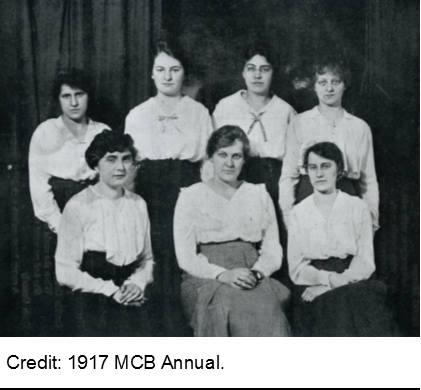By Catherine Walsh Davis BA’70, MM’76
In 1917, U-M celebrated its centennial, but the residence hall movement was in its nascence, with only Martha Cook, Helen Newberry, a few sororities, and League Houses (approved boarding houses) available to women. University-wide rules for women’s housing were still being developed, but those that existed were stringent by today’s standards and were meant to protect the reputations of the campus women.
A document of the Judiciary Council of the Women’s League, Uniform House Rules for Fall, 1916, spelled out eleven rules that all houses were to follow. They allowed each house to choose its own quiet hours for study and to elect a “house-head” and, “in houses of five or more girls, a house representative who shall meet with the Women’s League Board of Representatives.”
Beyond those allowances, the rules were restrictive: house rules were to be posted; “there shall be no mid-week dances;” freshmen were limited to three engagements per week, two of which had to be on the week-end; “girls are not to attend motion picture shows on Sunday”; houses were to close not later than 10 or 10:30 pm; girls who had to be out later than that, or who planned to leave town on the weekend had to obtain permission from the house-head, landlady, or chaperone; and “it is suggested that girls do not go to men’s rooming houses or fraternities” unless a chaperone was present.
One of the old rules paints a romantic picture of punting on the Huron River. It reads, “Engagements for boating shall terminate at 9 PM unless the party consists of more than two, in which case, 10:00 shall be the limit.”
There was no mention of a dress code in the rules, but this was the era before Prohibition with its flappers and short skirts and the girls probably never thought of wearing slacks in the Gold Room. Male visitation privileges were not spelled out in the centennial-era document, but, in 1904, Dean of Women Myra Jordan arranged with landladies for “parlor privileges” so women could entertain male callers, and it is likely that this practice continued after the opening of Martha Cook.
There were also no University rules stipulating that girls had to make their beds or keep their rooms clean. But there were such rules at MCB! In 1917, Social Director Grace Greenwood inaugurated a system where each resident’s room was evaluated weekly—on different, un-announced days—according to a system which allotted ten possible points to nine different categories of room cleanliness, ranging from overall aesthetics of the room to the orderliness of drawers and closets and the care in making the bed and the condition of the bed clothes. An additional five points were allotted to each of cleanliness and condition of the wash basin. While it is not clear if the same point scale was used continuously through the years, room inspections certainly were a part of life at Martha Cook until at least 1956.

